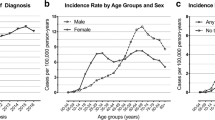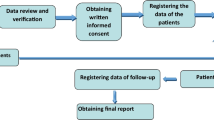Abstract
Incidence estimates for pituitary adenomas vary widely, suggesting the effects of numerous risk factors or varying levels of tumor surveillance. We studied the epidemiology of pituitary adenomas using 2004–2007 data collected by 17 Surveillance, Epidemiology, and End Results Programs in the United States (N = 8,276). We observed that incidence rates generally increased with age and were higher in females in early life and higher in males in later life. Males are diagnosed with larger tumors on average than females. Diagnosis may be delayed for males, giving tumors a chance to grow larger before clinical detection. We also observed that American Blacks have higher incidence rates for pituitary adenomas compared with other ethnic groups. There are several potential explanations for this finding with some evidence that at least part of the effect may be due to differential diagnosis between races.




Similar content being viewed by others
References
Buurman H, Saeger W (2006) Subclinical adenomas in postmortem pituitaries: classification and correlations to clinical data. Eur J Endocrinol 154:753–758
Costello RT (1936) Subclinical adenoma of the pituitary gland. Am J Pathol 12:205–216
Yamada S (2001) Epidemiology of pituitary tumors. In: Thapar K, Kovacs K, Scheithauer BW, Lloyd RV (eds) Diagnosis and management of pituitary tumors. Humana Press, Totowa, NJ
Melmed S (2003) Mechanisms for pituitary tumorigenesis: the plastic pituitary. J Clin Invest 112(11):1603–1618
Hemminki K, Försti A, Ji J (2007) Incidence and familial risks in pituitary adenoma and associated tumors. Endocr Relat Cancer 14:103–109
Franks S, Nabarro JDN (1977) Prevalence and presentation of hyperprolactinæmia in patients with “functionless” pituitary tumors. Lancet 1(8015):778–780
Ciccarelli A, Daly AF, Beckers A (2005) The epidemiology of prolactinomas. Pituitary 8:3–6
Heshmat MY, Kovi J, Simpson C, Kennedy J, Fan KJ (1976) Neoplasms of the central nervous system. Cancer 38:2135–2142
Fan KJ, Kovi J, Earle KM (1977) The ethnic distribution of primary central nervous system tumors: AFIP, 1958 to 1970. J Neuropathol Exp Neurol 36:41–49
Surveillance Research Program, National Cancer Institute (2010) About the SEER program. http://seer.cancer.gov/about/. Accessed 9 July 2010
Surveillance Epidemiology and End Results Program (2010) SEER*Stat database: incidence—SEER 17 regs limited-use + Hurricaine Katrina impacted Louisiana cases, Nov 2009 sub (2000–2007)—linked to county attributes—total U.S., 1969–2007 counties. April edn. National Cancer Institute, DCCPS, Surveillance Research Program, Cancer Statistics Branch
Fritz A, Percy C, Jack A, Shanmugaratnam K, Sobin L, Parkin DM, Whelan S (eds) (2000) International classification of diseases for oncology (ICD-O), 3rd edn. World Health Organization, Geneva
Tiwari RC, Clegg LX, Zou Z (2006) Efficient interval estimation for age-adjusted cancer rates. Stat Methods Med Res 15(6):547–569
The SAS Institute (2008) SAS, 9.2nd edn. The SAS Institute, Inc, Cary, NC
Nabarro JDN (1982) Pituitary prolactinomas. Clin Endocrinol (Oxf) 17:129–155
Thom T, Haase N, Rosamond W et al (2006) Heart disease and stroke statistics—2006 update: a report from the American heart association statistics committee and stroke statistics subcommittee. Circulation 113(6):e85–e151
Radhakrishnan K, Bahram M, Parisi JE, O’Fallon WM, Sunku J, Kurland LT (1995) The trends in incidence of primary brain tumors in the population of Rochester, Minnesota. Ann Neurol 37:67–73
Curtis E, Quale C, Haggstrom D, Smith-Bindman R (2008) Racial and ethnic differences in breast cancer survival: how much is explained by screening, tumor severity, biology, treatment, comorbidities, and demographics? Cancer 112:171–180
Bach PB, Cramer LD, Warren JL, Begg CB (1999) Racial differences in the treatment of early-stage lung cancer. N Engl J Med 341:1198–1205
Morris AM, Billingsley KG, Hayanga AJ, Matthews B, Baldwin L-M, Birkmeyer JD (2008) Residual treatment disparities after oncology referral for rectal cancer. J Natl Cancer Inst 100:738–744
Fenton JJ, Tancredi DJ, Green P, Franks P, Baldwin L-M (2009) Persistent racial and ethnic disparities in up-to-date colorectal cancer testing in medicare enrollees. J Am Geriatr Soc 57:412–418
Acknowledgments
The authors would like to thank Brian J. Smith for statistical advice, Michele West for assistance with SEER*Stat, and two anonymous reviewers for helpful feedback on an earlier draft of this manuscript. This project was supported in part by the National Institutes of Health (project numbers 5 P20 CA103672-05 and 5 P30 CA086862-10). Additional funding was provided by cooperative agreement number 5 U18 HSO16094 from the Agency for Healthcare Research and Quality. The content is solely the responsibility of the authors and does not necessarily represent the official views of the Agency for Healthcare Research and Quality.
Author information
Authors and Affiliations
Corresponding author
Rights and permissions
About this article
Cite this article
McDowell, B.D., Wallace, R.B., Carnahan, R.M. et al. Demographic differences in incidence for pituitary adenoma. Pituitary 14, 23–30 (2011). https://doi.org/10.1007/s11102-010-0253-4
Published:
Issue Date:
DOI: https://doi.org/10.1007/s11102-010-0253-4




